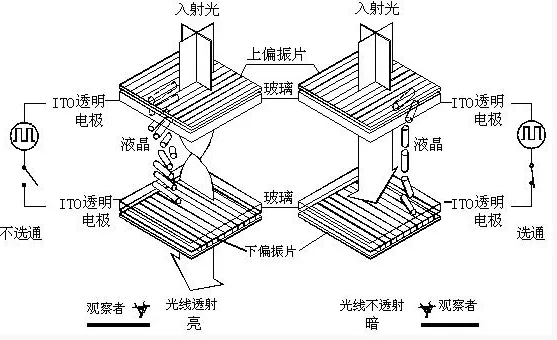常见的手表、数字仪表、电子钟及大部分计算器所用的液晶显示器件都是 TN 型器件。
一般,只要是笔段式数字显示所用的液晶显示器大都是 TN型器件。
1.结构原理
将涂有ITO透明导电层的玻璃光刻上一定的透明电极图形,将这种带有透明导电电极图形的前后两片玻璃基板夹持上一层具有正介电各向异性的向列相液晶材料,四周进行密封,形成一个厚度仅为数微米的扁平液晶盒。在玻璃内表面涂上一层定向心膜,并进行定向处理,因此在盒内液晶分子沿玻璃表面平行排列。两片玻璃内表面定向层定向处理的方向互相垂直,液晶分子在两片玻璃之间呈90°扭曲,这就是扭曲向列液晶显示器件名称的由来。
2. 工作原理
TN型液晶显示器件中液晶分子在盒中的扭曲螺矩远比可见光波长大得多,所以当沿一侧玻璃表面的液晶分子排列方向一致或正交的直线偏振光射入后,其偏光方向在通过整个液晶层后会被扭曲90°由另一侧射出,因此这个液晶盒具有了在平行偏光片间可以遮光而在正交偏光片间可以透光的作用和功能。
如果这时在液晶盒上施加一个电压并达到一定值后,液晶分子长轴将开始沿电场方向倾斜,当电压达到约两倍阈值电压后,除电极表面的液晶分子外,所有液晶盒内两电极之间的液晶分子都变成沿电场方向的再排列。这时,90°旋光的功能消失,在正交偏光片间失去旋光作用,使器件不能透光。而在平行偏光片之间由于失去了旋光作用,使器件也不再能遮光,如图所示。

因此,如果将液晶盒放置在正交或平行偏光片之间,即可通过给液晶盒通电的办法改变光的透过、遮住状态,从而实现显示。平时我们看见液晶显示器件时隐时现的黑字,不是液晶在变色,而是液晶显示器件使光透过或被吸收所致。
TN型液晶显示器件的工作阈值电压U与液晶盒厚度无关;选择大介电常数和小弹性常数可使阈值电压变小,实际使用中TN 型液晶盒的U为2~3V,有时在1V以下。
3.缺点
TN 型液晶显示器件的主要缺点如下。
(1)TN型液晶的电光特性不陡,所以工作在点阵显示方式下交叉效应严重,一般只适用于静态驱动或四路以下的动态驱动的笔段型显示中。目前TN型最好的器件也只可能实现8~16路驱动。
(2)电光响应速度慢。TN型液晶显示的响应速度为100ms左右,所以只适于显示静止或
变化比较慢的画面,视频显示是TN型液晶所不能胜任的。
(3) 光透过和关闭都不彻底。只能做到灰纸黑字的效果,而达不到白底黑字的效果,所以显示画面时对比度不理想。
以上这些缺点决定了TN型液晶虽然被广泛地使用,但只限于液晶中的低档产品。